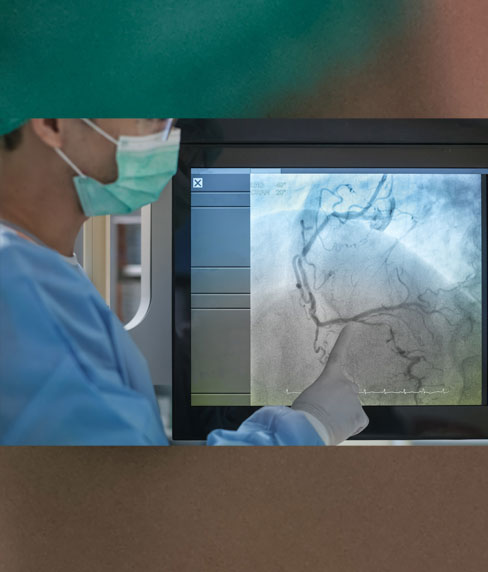A healthy heart is essential for living a full and quality life. When problems with your heart exist, cardiac catheterization is often needed to help diagnose and treat some of those problems. Cardiac catheterization is a common minimally invasive and low-risk procedure. These interventions help you get back to full health and full life.
Cardiac catheterization is also often referred to as a cardiac angiogram or heart catheterization. This procedure is used to evaluate structures of your heart with a primary focus on the arteries that supply blood to the muscle of the heart. This used to be performed through the artery in the groin but is now most often performed through the small artery in your wrist. A small catheter is threaded through the artery up to the heart, then a dye is injected into the heart arteries, and a type of X-ray machine is used to image those arteries. These images and readings guide treatments.

You must check in at the hospital one hour before your procedure where you will change into a patient gown. IV access will be done, and a nurse will obtain some medical information from you. After you are prepared, you will be taken to the Cath lab room, a type of operating room under a sterile environment, to undergo the procedure. You will be placed on a table under an X-ray machine called a fluoroscopy machine. The fluoroscopy machine is a large c-arm shaped machine that can rotate around you during the procedure for imaging purposes. We will then place some sterile drapes over the top of you and sterilize the catheterization access site on your wrist.
Once you are prepped and draped, the cardiologist will then obtain access to the artery in your wrist. They will numb the site before they poke the area with a needle. This causes a slight burn for only a few seconds. After your cardiologist has access to the artery, they will insert a sheath that they can thread different catheters through. This procedure is not painful, and you are awake so the cardiologist can talk with you about the findings.
If your cardiologist finds a restriction in an artery of the heart during the procedure, they can often fix these by ballooning and stenting the artery open. Stents are small metal coils or tubes that hold the artery open. Ballooning and stenting can all be done through the original access site and sheath that is in place. Occasionally, you may experience slight chest discomfort for a few seconds while the arteries are being ballooned open. While performing interventions on the arteries, you will receive some doses of a blood thinner to prevent blood clots. The cardiologist can typically give you some medication through the IV during the procedure to help with any anxiety you may experience.

After the procedure is complete, we’ll remove the catheter and sheath from the artery. We will place a pressure bandage over the puncture site to limit any bleeding that comes from the access site. If the catheterization goes through the groin, you will need to lie flat for a few hours while our professionals monitor for any bleeding. Then you will be moved back to the recovery unit.
After the procedure, you will be able to order something to eat and will be observed for a few hours. If you received stenting, you may need to spend the night and go home the following morning. If you did not receive stenting, you will usually go home the same day, but you will need someone to drive you home from the procedure.
At home, you will be restricted from lifting for about a week with the arm they accessed for the catheterization. Keep the insertion site clean and dry. Avoid soaking in water for about a week. Watch for any signs of infection, which include redness, swelling, pain, fever, chills, or discharge from the catheter access site. If these develop, contact the clinic as soon as possible.
You will be scheduled for a follow-up visit in our clinic within 1–2 weeks to evaluate how you are doing after the procedure. If you are prescribed any medications post-procedure, make sure you take these as directed because they are very important in preventing blood clots from forming in the placed stents.
Heart of Dixie Cardiology is dedicated to meeting your cardiology and other healthcare needs. Our interventional cardiologists are highly skilled, experienced, and board-certified to perform your heart catheterization and stenting, should you need it. We have been providing high-quality and compassionate care since 1997 and are proud to offer these services to you. Reach out to us today to get your questions answered and to schedule an appointment to see what we can do to help you live heart healthy.
Heart of Dixie Cardiology is dedicated to meeting your cardiology and other healthcare needs. Our interventional cardiologists are highly skilled, experienced, and board-certified to perform your heart catheterization and stenting, should you need it. We have been providing high-quality and compassionate care since 1997 and are proud to offer these services to you. Reach out to us today to get your questions answered and to schedule an appointment to see what we can do to help you live heart healthy.
